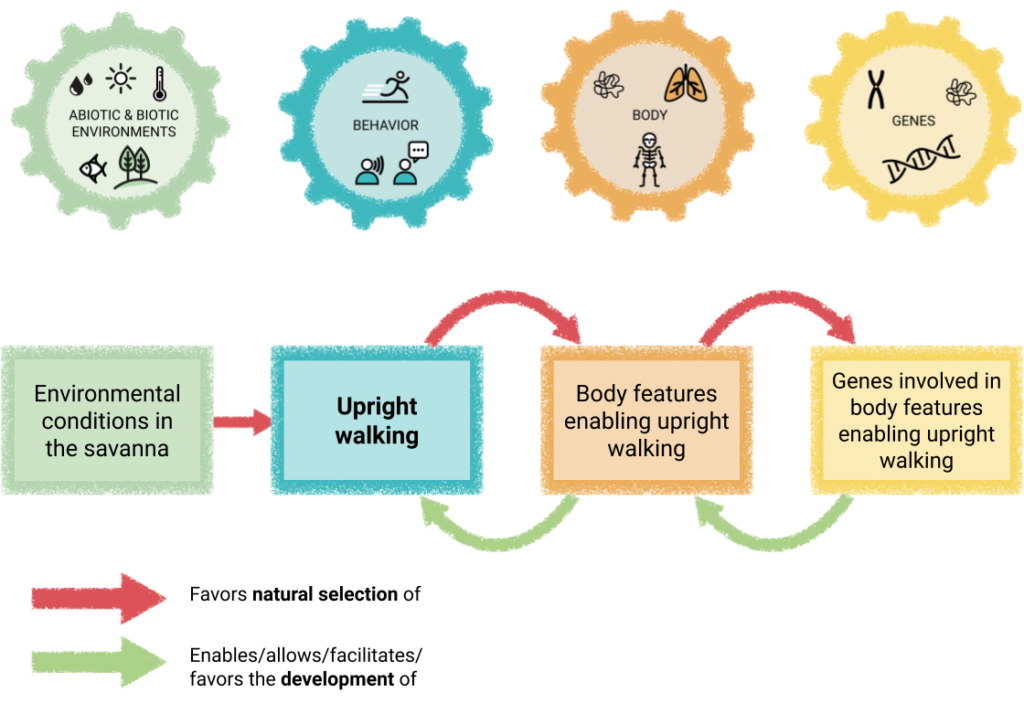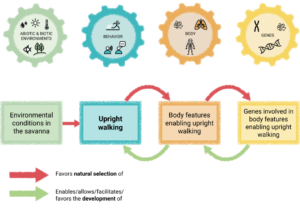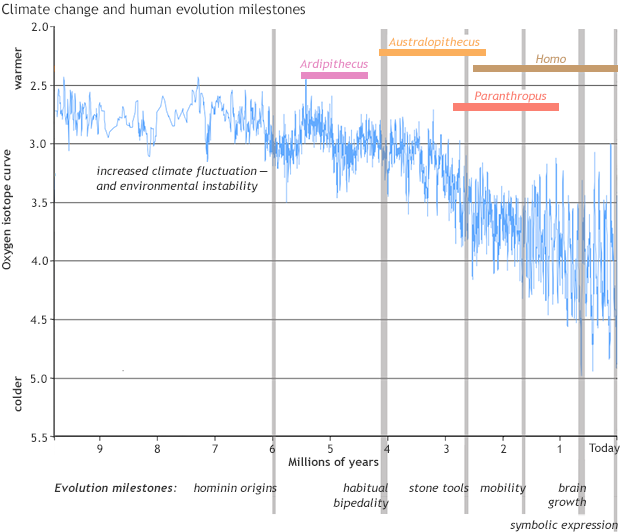Evolution of upright walking
Changes in environmental conditions
About 6 million years ago, a global change in the climate gradually began. This was, among others, caused by oscillations in the Earth’s orbit (so-called Milankovic cycles). The global climate gradually became cooler, but also increasingly unstable. Cool-dry and moist-warm phases alternated.
Uplift in the East African Rift Valley also caused the climate and landscape in East Africa to change significantly. The landscape turned into a mosaic of lakes, mountains, valleys and savanna woodlands.
Researchers can investigate changes in the climate of the past by studying marine sediments.
In the left diagram, high values indicate a warmer earth temperature and low values indicate a cooler earth temperature.
Image source: Smithsonian Institution
As biotic and abiotic environmental conditions change, so do the advantages and disadvantages of certain characteristics for the survival of organisms. One speaks of the function or consequences of traits: which functions or consequences does a trait have under given environmental conditions for the survival and the reproduction of an organism?
For example, depending on environmental conditions, certain diets are more beneficial than others. Depending on the environmental conditions, certain forms of locomotion are more advantageous than others. Many living things can change their behavior quickly and more or less flexibly. However, living beings can not drastically change their certain aspects of their morphology and physiology during their lifetime. The change in these traits occurs only at the level of a population – those whose traits cause them to survive and reproduce better than others will have more offspring, and if the trait is inherited to those offspring, it will become more prevalent in the population.
The interplay between environmental conditions, behavior, physical characteristics, and their advantages/disadvantages for survival and reproduction, over many generations can lead to certain modes of locomotion spreading in a population.
Causal map for upright walking

About 6 million years ago, the environmental conditions under which our ancestors lived began to change. The landscape, flora and fauna changed gradually and over many generations, from a tropical rainforest, to a tree and shrub savanna.
The environmental conditions of the savannah meant that the behavior of upright walking had many advantages for survival and reproductive success (fitness advantage; e.g. by carrying food to the group or carrying sticks and stones to stay safe from predators).
Thus, these conditions acted as selection pressure for upright walking. Hominids who were walking upright (regardless of whether they were “aware” of the benefits or “intentionally” performed this behavior) would have a fitness advantage over those in their population who did not perform that behavior. Among those who engaged in upright walking, those who had body features that enabled, facilitated, or made this behavior more efficient, would have a further fitness advantage. Among those who had the best physical features for upright walking, those whose different genetic predisposition enabled the development of these body features, in turn had a fitness advantage. Their traits would be inherited to their offspring, who would also have a fitness benefit due to their improved upright walking ability.
All of this has resulted in the natural selection of the behavior “upright walking”, the body structures that enable upright walking, and the genes involved in the development of these body structures, in the populations of our ancestors. We have inherited these characteristics from them.
Lesson plan: Evolution and development of upright walking
This document contains a collection of activities and resources related to the evolution and development of upright walking in our species

Chalkboard materials: Causal map on upright walking
Chalkboard materials for constructing a causal map for the evolution of upright walking

Handout: Introduction to causal maps with the example of upright walking
A handout that introduces students to the causal map to map the evolution and development of traits, with the example of upright walking

Worksheet: Natural selection of upright walking
A worksheet in which students calculate and graph the changes in the frequencies of traits related to upright walking in a population over several generations, exploring the role of variation, fitness consequences and trait inheritance in evolutionary change.

Model criticism: The animated graph and visual model on left represents the general population dynamics in relation to the fitness advantages of upright walking. However, this is just a simple representation. Can you identify some simplifications in the model that would not be reflected in the reality of our hominid ancestral populations?
Perspectives from child development
We do not come into the world with an ability to walk upright. Instead, over the course of our first year of life, we incrementally learn this behavior.
Our social environments are important causal factors in this development – parents and other people support and encourage us to take our first steps towards exploring the world.
- Would we as a baby learn to walk upright if not for all the other people in our social environment walking upright and encouraging us to do the same?
- Do you think the social environments of our hominid ancestors served as causal factors in the development upright walking?
- Do you think this social aspect of the behavior of upright walking has had an influence on the evolution of upright walking?
- How could you revise the causal map for upright walking (above) to incorporate the social environment as a causal factor in the development and/or evolution of this trait?

A causal map that includes the additional role of the social environment in the development of the behavioral trait “upright walking”
One way to understand the role of the social cultural environment in the development of upright walking is to study babies across different cultures. Scientists find that there is indeed quite some variation – more than previously thought – in how the motor skills of children develop, and this seems to relate to cultural differences in caregiving practices, routines, and parental beliefs.
- Academy of Pediatric Physical Therapy (2018). Motor Development Variations Across Cultures Implications for Culturally Competent and Family-Centered Pediatric Care.http://www.apta.org/CulturalCompetence/Vision/
- Gupta, S. (2019). Culture helps shape when babies learn to walk. Motor development models based on Western standards are too narrow. Science News.
Humans walking on all fours?
In the last decade, scientists have become aware of humans who have not developed the ability to walk bipedally but instead habitually walk on hands and feet. This phenomenon has become known as Uner Tan Syndrome, named after the scientist who first documented it in a family in Turkey.
Scientists have studied these cases to understand why these individuals develop this form of locomotion. This phenomenon offers unique opportunities for reflecting on causation in the development of human locomotion in the classroom.
Various videos exist on Youtube about this phenomenon, including:
-
a BBC documentary “The Family that Walks on All Fours”. https://www.youtube.com/watch?v=Jwiz-yhLpT0 (59:03 min)
-
Remote village where people walk on all fours | 60 Minutes Australia https://www.youtube.com/watch?v=6GlNQzjii1c(15:44 min)
See Lesson materials on upright walking for classroom discussion ideas around the Uner Tan Syndrome
See Causal mapping materials (slide 17) for a possible causal map showing the interactions of possible/presumed factors leading to Uner Tan Syndrome.
References
Academy of Pediatric Physical Therapy (2018). Motor Development Variations Across Cultures Implications for Culturally Competent and Family-Centered Pediatric Care. Academy of Pediatric Physical Therapy Fact Sheet/Resource. Retrieved from http://www.apta.org/CulturalCompetence/Vision/
Carvalho, S., Biro, D., Cunha, E., Hockings, K., McGrew, W. C., Richmond, B. G., & Matsuzawa, T. (2012). Chimpanzee carrying behaviour and the origins of human bipedality. Current Biology, 22(6), R180–R181. https://doi.org/10.1016/j.cub.2012.01.052
Gupta, S. (2019). Culture helps shape when babies learn to walk. Motor development models based on Western standards are too narrow. Science News. https://www.sciencenews.org/article/culture-helps-shape-when-babies-learn-walk?fbclid=IwAR0uZEVwnC_BiUIbPhBU6adNIXL-HD4oGDTyzh1QnBB8M0QBLH9YDg-qLj4
Humphrey, N., Skoyles, J. R., & Keynes, R. (2005). Human Hand-Walkers: Five Siblings Who Never Stood Up. CPNSS Discussion Paper. https://doi.org/10.1111/j.0006-341X.2005.171_1.x
Karasik, L. B., Adolph, K. E., Tamis-Lemonda, C. S., & Bornstein, M. H. (2010). WEIRD walking: Cross-cultural research on motor development. Behavioral and Brain Sciences, 33(2–3), 95–96. https://doi.org/10.1017/S0140525X10000117
Rachwani, J., Hoch, J. E., & Adolph, K. E. (in press). Action in development: Variability, flexibility, and plasticity. In Tamis-LeMonda, C. S., & Lockman, J. J. (Eds.). Handbook of infant development. Cambridge University Press.



